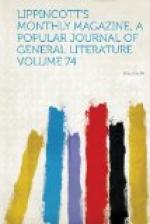Sweetheart, I tell thee, I, a woman born
To live by music, and to soar and sing,
As stars for shining, flowers for blossoming,
Could never sit beneath the stars and
mourn
With missing aught from such high destinies.
That is very suggestive of Mrs. Browning’s style, and it were easy to multiply instances; such as this, for example, from the poem called “In York:”
The broad vaulted aisles are so still
we can hear
The silences bend thro’ the loneliness,
listening
To the eloquent brasses that burn at our
feet,
With holy signs glistening.
This is the worst form of Browningese. Exactly what Mrs. Aitken meant by it she probably knows as little as any of us; but we would humbly suggest to her that one does not hear anything bend, unless it be of a creaking nature, like an old tree, and that is rather opposed to one’s idea of “silences,” vague as our notions of that plural noun are. Why one “silence” could not serve her turn is one of those Dundrearyan conundrums that no fellow can find out. And, while we are about it, we should like to know whether it is the silences or the loneliness or “we” that listen to the eloquent brasses, and to inquire mildly why the poet threw away the opportunity to say the “brazen eloquences,” which would have been novel and striking, and quite in the vein of her great original. If Mrs. Browning can talk about “broken sentiency” and “elemental strategies,” why should not Mrs. Aitken aspire to hear the silences bend? To do her justice, she does not use such expressions very often—her style is usually simple and comprehensible—but she does sometimes make the mistake of confounding incomprehensibility and power. She has some pretty descriptions of Nature here and there, and one or two of her ballads are very good, especially that called “A Story of Tours;” but her sonnets are none of them constructed after the genuine Italian model, and generally end with a couplet. Her blank verse is the worst of all. The most ambitious poem in the book is that called “A Day in the Life of Mary Stuart,” a dramatic poem in three scenes, dated the last of January, 1567. It contains a scene between the queen and her maidens, a scene with the Presbyterian deputies, and a scene with Bothwell, wherein she incites him to the murder of Darnley. It is unfortunate that the poem should have appeared in the same year with Swinburne’s Bothwell, that magnificent study of the character of Mary Stuart. The characters in Mrs. Aitken’s sketch are weak and thin, and the verse intolerable. She divides the most inseparable phrases to make out her measure, and constantly ends the lines with a preposition. No torturing of the voice can make verse of such sentences as these:
He
bids
Your grace deny Lord Bothwell’s
wish to be
Made member of the council, and if so
Be you delay, he—
In the scene with Bothwell the queen declares her love to him thus:




